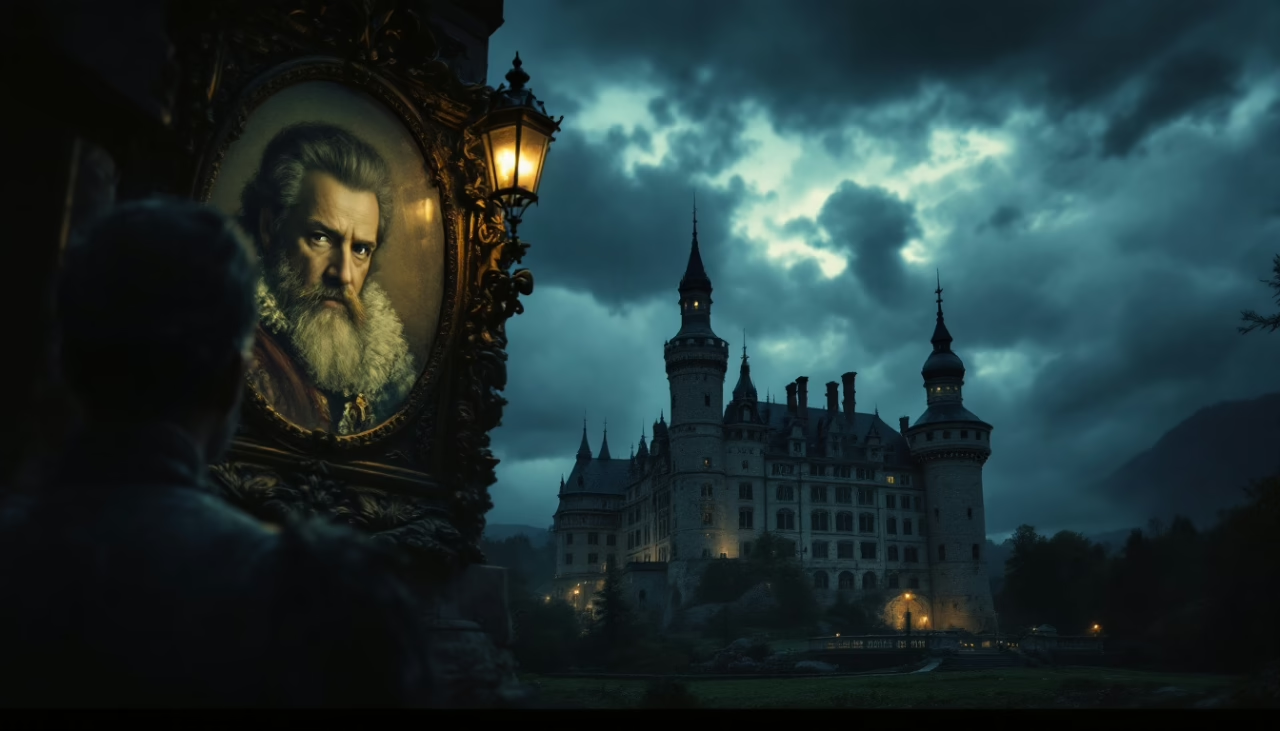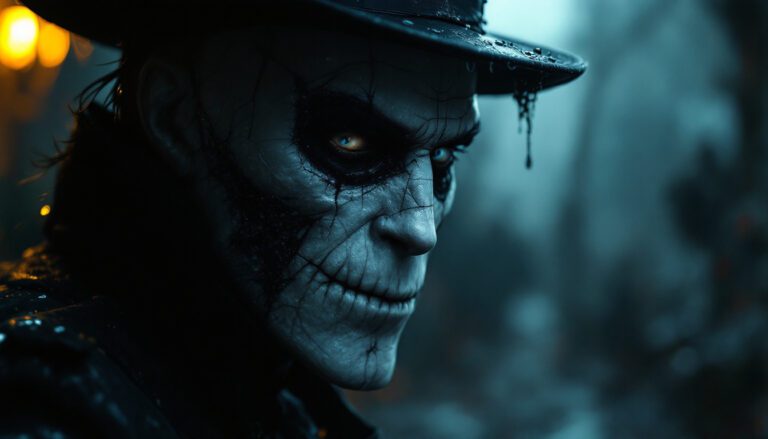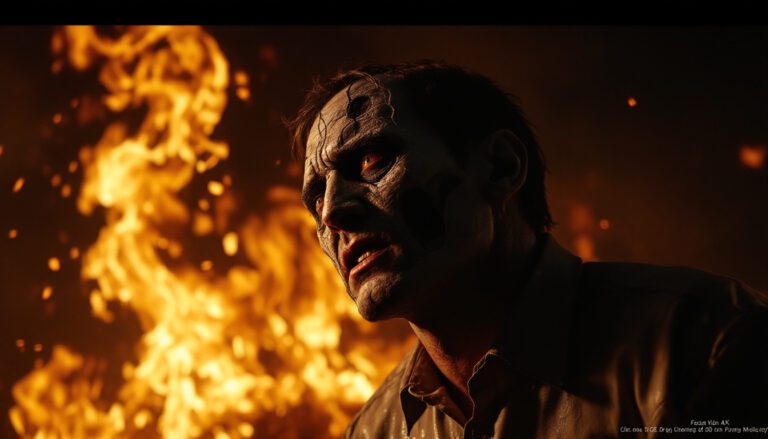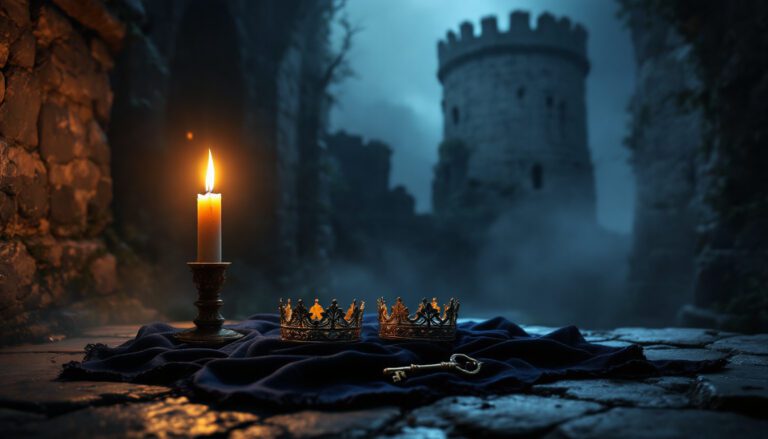Death of Ludwig II: Accident or Murder?

The death of Ludwig II remains an enigma that straddles the line between accident and murder.
Witness accounts present a chaotic scene, influenced by adverse weather and perilous terrain.
Yet, lurking beneath the surface are political motives and conflicting testimonies that suggest deeper intrigue.
The unresolved circumstances of his demise invite scrutiny and speculation. What truths lie hidden in the shadows of history, waiting to be uncovered?
Summary of Key Points
Hide- Ludwig II's death remains shrouded in mystery, with conflicting eyewitness accounts leading to speculation of both accident and foul play.
- The accident theory posits a tragic misadventure due to turbulent weather and challenging terrain near Lake Starnberg.
- Allegations of murder suggest political rivals may have orchestrated his demise, driven by threats to his reign.
- Inconsistent autopsy findings and witness testimonies raise questions about the thoroughness of the investigation into his death.
- Modern forensic techniques could potentially shed light on the circumstances, but significant gaps in historical records complicate definitive conclusions.
Setting the Stage: A Monarch’s Final Days

As Ludwig II approached the twilight of his reign, the eccentricities that defined his rule became increasingly pronounced, leaving a kingdom divided between admiration and skepticism.
On the fateful day of his demise, the intricate tapestry of his life—marked by artistic ambition and political isolation—intertwined with an atmosphere thick with intrigue and foreboding.
This confluence of personality and circumstance invites a critical examination of the events leading to his enigmatic end.
Overview of Ludwig II’s Reign and Personality
Ludwig II’s reign was marked by an extraordinary patronage of the arts and an eccentric lifestyle that captivated and perplexed his contemporaries.
Amidst the cultural and political turmoil of 19th-century Bavaria, his visionary pursuits often clashed with the practical demands of governance, creating a complex legacy.
As his final days approached, the dichotomy between his opulent dreams and the stark realities of his kingdom set the stage for a dramatic conclusion to his life.
His patronage of the arts and eccentric lifestyle
Although often perceived as a reclusive ruler, Ludwig II’s life was a colorful tapestry woven with threads of artistic patronage and eccentricity.
His unwavering support for composers like Wagner and architects like Neuschwanstein transformed Bavarian culture.
This devotion to the arts, coupled with his whimsical lifestyle—marked by extravagant castles and mythic obsessions—reveals a complex monarch who sought to transcend the mundane through beauty and imagination.
The cultural and political climate of 19th-century Bavaria
The cultural and political climate of 19th-century Bavaria was a complex interplay of tradition and transformation, marked by a burgeoning sense of nationalism and the pressures of modernization.
Amidst this backdrop, Ludwig II’s reign embodied both romantic idealism and the struggle for self-definition. His artistic pursuits clashed with rising political tensions, revealing a society teetering between conservative heritage and the yearning for progressive change.
The Day of His Demise
On the fateful day of Ludwig II’s demise, a confluence of unsettling circumstances marked the monarch’s final moments.
Eyewitness accounts, steeped in confusion and intrigue, hinted at an atmosphere thick with tension, while initial investigations struggled to piece together the events leading to his disappearance.
As the shadow of suspicion loomed, questions about the nature of his death—accident or foul play—began to emerge, igniting a debate that has persisted through the ages.
Circumstances surrounding his disappearance
As whispers of discontent echoed through Bavaria, the final days of Ludwig II unfolded under a shroud of intrigue and uncertainty.
Isolated within the confines of his own castle, the king faced mounting pressure from both political rivals and advisors.
His erratic behavior raised eyebrows, while his aversion to authority intensified, creating an environment ripe for speculation about his fate and the potential forces at play.
Eyewitness accounts and initial investigations
While the sun dipped below the horizon on that fateful evening of June 13, 1886, the atmosphere around Lake Starnberg was thick with tension and uncertainty.
Eyewitness accounts later revealed conflicting narratives—some claiming to see Ludwig’s figure struggling in the water, others asserting his calm demeanor before disappearance.
Initial investigations were marred by inconsistencies, fueling speculation about whether his death was an unfortunate accident or a calculated murder.
Divergent Theories on the Death
The circumstances surrounding Ludwig II’s death have sparked intense debate, leading to two prominent theories: one suggesting a tragic accident and the other positing a sinister murder.
Proponents of the accident theory argue that the monarch’s demise was a result of misfortune, while the murder theory raises unsettling questions about political motives and conspiracies.
This divergence invites a closer examination of the evidence and implications surrounding the enigmatic end of a king.
The Accident Theory
The Accident Theory surrounding Ludwig II’s death presents a compelling narrative of misfortune rather than foul play.
Official reports and autopsy findings suggest a tragic misadventure, raising questions about the circumstances leading to his untimely demise.
As the evidence unfolds, one must consider whether these elements truly align with a mere accident or hint at deeper, unresolved mysteries.
Evidence supporting a tragic misadventure
Although skepticism surrounds the circumstances of Ludwig II’s death, evidence supporting the theory of a tragic misadventure emerges from various accounts and testimonies.
Witnesses reported turbulent weather and challenging terrain near Lake Starnberg, suggesting that Ludwig may have succumbed to the elements.
Additionally, his known affinity for solitary excursions raises the possibility of an unforeseen accident, rather than foul play.
Official reports and autopsy findings
Official reports and autopsy findings present a complex portrait of Ludwig II’s final moments, reinforcing the accident theory while simultaneously raising questions about the thoroughness of the investigations.
Discrepancies in witness testimonies and the lack of conclusive evidence cast shadows over the narrative of accidental drowning. Such ambiguities fuel ongoing debates, inviting scrutiny into whether a tragic misadventure was truly the complete story.
The Murder Theory
The circumstances surrounding Ludwig II’s death have led to intense speculation about the possibility of foul play, with allegations of conspiracy weaving through the corridors of power.
Political motives—rooted in a turbulent royal court—suggest that his demise may have been orchestrated by those threatened by his reign.
Such theories challenge the narrative of an accidental drowning, prompting a closer examination of the intrigues that marked his final days.
Allegations of foul play and conspiracy
What truly transpired on that fateful night when Ludwig II of Bavaria met his mysterious end?
Allegations of foul play and conspiracy have long circulated, suggesting a calculated plot to eliminate a monarch deemed unfit.
Eyewitness accounts and peculiar circumstances fuel speculation, igniting debate over whether external forces conspired against him.
This tantalizing enigma invites scrutiny into the shadowy domains of power and betrayal.
Political motives and the role of court intrigue
Amidst the swirling currents of ambition and power, political motives emerge as a compelling lens through which to examine the death of Ludwig II of Bavaria.
Court intrigue swirled around Ludwig, with rivals keen to eliminate a monarch perceived as a threat to their interests.
Theories of murder resonate, suggesting that his death was orchestrated to secure control over Bavaria and quash his vision of freedom.
Investigating the Evidence
The evidence surrounding Ludwig II’s untimely death invites scrutiny through both forensic analysis and historical records, each offering a lens through which to reassess the circumstances of that fateful night.
Modern reinterpretations challenge the established narrative, igniting debates that question the very nature of truth in historical accounts.
As investigators sift through the remnants of the past, the possibility of murder looms large, compelling a reevaluation of what is known and what remains shrouded in mystery.
Forensic Analysis and Historical Records
The examination of Ludwig II’s death through forensic analysis and historical records reveals a complex interplay between medical insights and environmental factors.
A critical review of police reports alongside the circumstances surrounding his demise raises unsettling questions about the nature of his passing.
Was it a tragic accident, or does the evidence suggest a more sinister plot at play?
Review of medical and police reports
Forensic scrutiny of the medical and police reports surrounding Ludwig II’s mysterious death reveals a complex web of evidence that raises more questions than it answers.
Key findings include:
- Inconsistent eyewitness accounts regarding the circumstances of his death.
- Anomalies in the autopsy results that suggest foul play.
- Lack of thorough investigation into potential political motives.
These factors create an environment ripe for speculation and intrigue.
Analysis of the environmental and situational factors
Amidst the swirling uncertainties of Ludwig II’s death, examining the environmental and situational factors surrounding the event offers a deeper understanding of the context in which it unfolded.
The isolated lake, turbulent weather, and political tensions of the time created a precarious atmosphere.
These elements not only influenced the circumstances of his demise but also fueled speculation about potential foul play, inviting further scrutiny.
Modern Reinterpretations and Debates
Recent scholarly research has begun to challenge long-held beliefs about Ludwig II’s death, introducing alternative viewpoints that question the official narrative.
The advent of modern technology, including advanced forensic techniques and digital reconstructions, has opened new avenues for scrutinizing historical evidence.
This evolving landscape prompts a reevaluation of the circumstances surrounding his demise, blurring the lines between accident and foul play.
Recent scholarly research and alternative viewpoints
While the circumstances surrounding Ludwig II’s untimely demise have long fueled speculation, contemporary scholarly research has begun to unravel the complex tapestry of evidence that supports various interpretations of his death.
Key alternative viewpoints include:
- The possibility of political assassination by rivals.
- The role of mental health and its implications on his behavior.
- The enduring legend of his supposed escape to freedom.
These perspectives invigorate ongoing debates.
Impact of technology on re-examining historical events
The advent of modern technology has revolutionized the examination of historical events, allowing scholars and enthusiasts alike to scrutinize long-standing mysteries with fresh eyes.
Advanced forensic techniques, digital archiving, and data analysis challenge traditional narratives, revealing new interpretations of events like Ludwig II’s death.
This technological shift fosters debate, encouraging a reevaluation of accepted truths and inviting individuals to pursue a more liberated understanding of history.
Cultural Impact and Legacy
The enigmatic death of Ludwig II has transcended historical inquiry to become a vibrant mosaic woven into the cultural fabric of Bavaria and beyond.
This duality of the myth and the man shapes contemporary perceptions of Bavarian identity, infusing national memory with a sense of nostalgia and intrigue.
As the boundaries between fact and fiction blur, Ludwig’s legacy challenges society to confront the complexities of power, artistry, and the human condition.
The Myth and the Man in Popular Culture
Ludwig II’s enigmatic death has inspired a vibrant mosaic of portrayals in literature and film, transforming him into a figure shrouded in myth and speculation.
This artistic fascination reflects not just the historical events surrounding his demise, but also society’s enduring intrigue with his larger-than-life persona.
As narratives continue to evolve, they reveal the complex interplay between reality and legend that defines Ludwig’s cultural legacy.
How Ludwig II’s death has been portrayed in literature and film
How has the enigmatic death of Ludwig II shaped narratives in literature and film? His demise evokes intrigue, inspiring a spectrum of interpretations:
- Murder theories exploring political conspiracies and royal betrayal
- Romanticized portrayals emphasizing the tragic hero’s fall from grace
- Mystical interpretations linking his death to fate and the supernatural
These themes reflect society’s ongoing fascination with power, mystery, and the fragility of life.
Enduring fascination with his mysterious persona
Mystique surrounds the figure of Ludwig II, a king whose life and untimely death have sparked enduring fascination across generations.
His enigmatic personality, characterized by artistic grandeur and perceived madness, challenges conventional narratives of power.
This duality captivates artists and historians alike, resulting in a cultural legacy that continues to inspire exploration into the boundaries of freedom, creativity, and the human experience.
Influence on Bavarian Identity and National Memory
Ludwig II’s architectural masterpieces, including the fairy-tale castles of Neuschwanstein and Linderhof, have become essential symbols of Bavarian identity, intertwining regional pride with a romanticized view of monarchy.
His enigmatic life and untimely death have reshaped perceptions of royalty, fostering a complex legacy that oscillates between admiration and skepticism.
As Bavaria navigates its cultural heritage, Ludwig’s story continues to resonate, provoking discussions about the nature of leadership and the allure of the past.
The legacy of his architectural projects and patronage
The enduring fascination with King Ludwig II’s architectural endeavors reflects a profound cultural legacy that continues to shape Bavarian identity and national memory.
His projects symbolize not just grandeur but also:
- A romanticized vision of Bavarian heritage
- An attraction that fuels tourism and economic growth
- An ongoing dialogue about the intersection of art, power, and identity
These elements contribute to Bavaria’s unique cultural tapestry.
How his story shaped modern perceptions of royalty
Romanticism and tragedy intertwine in the narrative of Bavaria’s enigmatic king, shaping contemporary perceptions of royalty in profound ways.
Ludwig II’s mysterious demise and extravagant lifestyle evoke a complex blend of admiration and skepticism towards royal figures. His story challenges notions of power, privilege, and the burdens of leadership, fostering a collective Bavarian identity that both cherishes and critiques its historical monarchs.
Unanswered Questions and Future Research
The enigmatic circumstances surrounding Ludwig II’s death continue to cast a shadow over historical discourse, revealing significant gaps in the available records.
This absence of clarity breeds fertile ground for conspiracy theories, which have gained traction in contemporary discussions about his demise.
Future research must confront these uncertainties head-on, challenging established narratives while probing the psychological allure of speculation in the absence of definitive answers.
Gaps in the Historical Record
The mysterious circumstances surrounding Ludwig II’s death are compounded by significant gaps in the historical record, including missing documents and inconsistent testimonies.
Such discrepancies open avenues for modern forensic science to potentially uncover new insights into the events of that fateful night.
As researchers confront these unanswered questions, the quest for clarity may not only reframe historical narratives but also challenge long-held assumptions about the king’s demise.
Missing documents and conflicting testimonies
Mystery shrouds the circumstances surrounding Ludwig II’s death, with missing documents and conflicting testimonies amplifying the intrigue.
This lack of clarity raises pivotal questions:
- Discrepancies in eyewitness accounts suggest potential manipulation.
- Key documents related to the investigation have vanished.
- Inconsistencies in official reports hinder a thorough understanding.
Such gaps in the historical record invite further scrutiny and demand exploration into the truth behind the enigmatic demise.
Areas where modern forensic science could provide insights
With numerous inconsistencies and missing documentation surrounding Ludwig II’s death, modern forensic science offers a promising avenue for unraveling this historical enigma.
Techniques such as DNA analysis, toxicology, and digital reconstruction could illuminate the circumstances of his demise.
The Role of Conspiracy Theories Today
The enduring debate surrounding Ludwig II’s death is fueled by a potent mix of media influence and public fascination with unresolved mysteries.
Conspiracy theories thrive in the absence of definitive answers, allowing speculation to flourish and capturing the imagination of both historians and enthusiasts alike.
As new evidence emerges and old narratives are reexamined, the question of whether his demise was an accident or a calculated act remains a compelling topic for future research.
Media influence and public intrigue in unresolved mysteries
How does media shape public perception of unresolved mysteries like the death of Ludwig II? The relentless pursuit of sensationalism cultivates intrigue, often overshadowing facts.
This influence manifests through:
- Amplified conspiracy theories, fueling speculation
- Emotion-driven narratives that captivate audiences
- A cycle of misinformation, challenging the quest for truth
Thus, media not only reflects public curiosity but intensifies the enigmatic allure surrounding historical enigmas.
Why the debate over his death endures
Why does the debate surrounding Ludwig II’s death continue to captivate historians and enthusiasts alike?
The allure lies in unresolved questions, conflicting narratives, and the tantalizing possibility of conspiracy.
Each theory—accident or murder—evokes a longing for truth, reflecting society’s broader struggles against authority and secrecy.
As new evidence emerges, the quest for clarity remains a compelling demonstration of the human spirit’s desire for freedom.
Wrapping Up
The death of Ludwig II remains a riddle wrapped in the fog of history, much like a ship lost in a storm.
As theories of accident and murder collide, the truth remains elusive, leaving a haunting void that both intrigues and frustrates scholars and enthusiasts alike.
With each new investigation, the shadows of doubt deepen, prompting the continuous quest for answers.
Hence, Ludwig’s legacy endures, suspended between reality and myth, forever enchanting the imagination of those who seek clarity.





